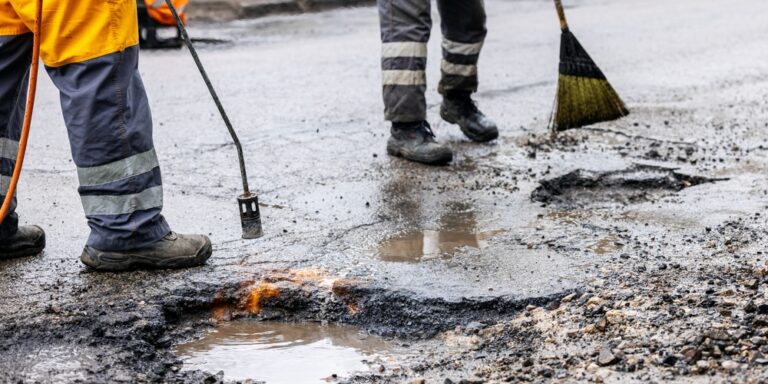— 5 min read
Pothole Repair Basics: Methods, Costs and Best Practices
Last Updated Apr 7, 2025
Last Updated Apr 7, 2025

Potholes: a universal nuisance that no driver wants to encounter. If left unattended, they can cause damage to vehicles and roadways, negatively impact an area's aesthetics and be a safety hazard for both vehicles and pedestrians. Proper repair helps road maintenance teams and contractors mitigate damage, reduce risks and restore the road to its proper condition.
This article will discuss what causes potholes, the fundamentals of pothole repair, plus costs, pothole prevention and repair durability.
Table of contents
Common Causes of Potholes
Potholes are the result of the pavement’s top layer becoming unable to support the weight of traffic. This is generally caused by overuse from traffic, as well as water erosion.
Water from rain, melting snow and ice can seep through cracks in the pavement and become trapped. In colder climates, this moisture repeatedly freezes and expands, widening the cracks and weakening the pavement over time. In warmer regions, heavy rainfall and poor drainage accelerate pavement deterioration by softening the underlying layers and washing away supporting materials.
This process, combined with the constant pressure from traffic, gradually weakens the road surface from both above and below, causing potholes to grow larger over time.
3 Common Pothole Repair Methods
Potholes are difficult to repair long-term because roads are constantly under stress from traffic, weather and natural wear. Many repair methods, especially those used in cold weather, are temporary solutions that don’t fully address underlying pavement damage.
There are three pothole repair methods that construction professionals use. Each has its own benefit and primary application. Choosing the right pothole repair method helps extend the road’s lifespan and may prevent new potholes from forming.
1. Cold Patch Repairs
Cold patch repairs are done using a blacktop material that does not require heating or mixing. The material is poured into the pothole and compacted into the hole using a shovel or even a car tire. The end result is a filled pothole that can withstand some traffic — but isn’t meant to be permanent.
While cold patch asphalt is often a go-to solution for quick pothole repairs, it is typically a temporary fix, especially during the winter months. Many choose it because:
- It’s simple to use, requiring no special equipment or heating.
- It can be done even in the colder months.
- Cold patch repairs are typically the least expensive pothole repair option.
However, when more permanent repair methods become available in warmer months, construction professionals usually opt for hot-mix asphalt or full-depth patching, as they provide longer-lasting results without the bonding issues and weather-related limitations of cold patch repairs.
2. Hot Mix Asphalt Repairs
Hot mix asphalt consists of a mixture containing stone, sand or gravel bound by asphalt cement. The mixture is heated, combined and mixed, then transported to the jobsite. Once it arrives, it is placed into the pothole, then compacted using road construction equipment like a heavy roller. The mixture is usually ready to be driven on once it cools.
For larger jobs or jobs during warmer months, hot mix asphalt is usually the choice for pothole repair. It offers a more permanent solution than cold patch repairs due to its ability to bind well to the existing pavement.
Roads repaired with hot mix offer a smooth and safe driving experience, as well as durability and the ability withstand extreme weather conditions. However, hot mix is only available during warmer months because it must be applied at high temperatures. If it cools too quickly, it won’t bond properly, leading to weaker repairs that need to be fixed in the future.
3. Full-Depth Patching
A full-depth asphalt patch is required when minor repairs continually fail and the road section must be replaced with a fresh mixture to make sure the area is structurally sound. A large patch of road is cut out and as much pavement as necessary is removed. Then, a tack coat is applied to the vertical faces of the area.
The asphalt mixture is then laid down and carefully spread to avoid segregating the mixture. The finished surface should be level with the surrounding pavement once cooled.
Once the mixture is properly laid, specialized equipment compacts the asphalt. A small compactor is typically used for smaller patches, while a roller is preferred for larger projects.
Full-depth patching offers a cost-effective, expedited and localized solution for municipalities and crews looking to solve their pothole problem quickly.
All three of these patching methods can repair surface damage, but they don’t always solve deeper problems in the road’s base. If the damage runs deeper, resurfacing or full-depth reconstruction might be a better long-term solution.
Depending on how much stress it is under, a pothole patch can last for up to a year, sometimes more. Patches are just temporary fixes, though, and should be replaced by a more permanent solution when possible.
Pothole Repairs Cost
On average, a pothole can vary in cost depending on a number of elements, ranging from its size and depth, ground conditions, weather, and the cost of materials and labor.
Construction professionals can use an asphalt calculator to determine the amount of asphalt needed for a project, then determine how much it would cost for them to complete it. However, the costs associated with labor, equipment and mobilization are the largest factors contributing to the price of pothole repair.
Explore data and trends for building materials prices.
Get the latest U.S. retail prices and view historical trends for common building materials.
Proper Repair Prolongs the Lifespan of Roads and Highways
By addressing the root causes of potholes — such as water infiltration and traffic stress — road maintenance teams can choose the most appropriate repair method. Investing in the right repair approach not only prolongs the lifespan of roads, but also ensures safer driving conditions and preserves the aesthetic appeal of roadways.
Was this article helpful?
Thank you for your submission.
0%
0%
You voted that this article was . Was this a mistake? If so, change your vote here.
Scroll less, learn more about construction.
Subscribe to The Blueprint, Procore’s construction newsletter, to get content from industry experts delivered straight to your inbox.
By clicking this button, you agree to our Privacy Notice and Terms of Service.
Categories:
Tags:
Written by
Julia Tell
45 articles
Julia Tell is a freelance writer covering education, construction, healthcare, and digital transformation. She holds a Ph.D. in Media & Communications and has written for publications including Business Insider, GoodRx, and EdSurge, as well as nonprofits, international businesses, and educational institutions.
View profileExplore more helpful resources

How to Understand and Use Architect’s Supplemental Instructions
Architect’s supplemental instructions, also known as ASI, offer a means of making small changes to the construction contract after it’s signed. The ASI is a document issued by the architect...
Improving Project Monitoring with Construction Quantity Tracking
Once a construction project is underway, builders need to closely monitor the project’s progress and make sure it’s staying on schedule and within budget. Quantity tracking helps construction leaders manage...

Streamlining Construction Projects with Effective BIM Coordination
The old saying goes: if you fail to plan, you plan to fail. Construction professionals know this better than nearly anyone. To take a project from a vision in an owner’s...

Construction Invoice Factoring: A Quick Guide
Construction companies need to maintain consistent cash flow. Projects can take years to complete, and delays and unforeseen events may keep expenses mounting. Adding to this load are typically high upfront...